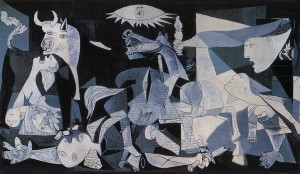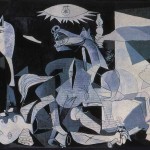 In June of 1937, Pablo Picasso created a masterpiece to convey the negative effects of war by recreating a real event. Guernica is a city that the Nazis bombed during the Spanish Civil War. The bombing occurred on April 27, 1937. Nazi forces bombarded Guernica without caring that it held no strategic military value. Guernica’s bombing was the first aerial saturation bombing of a civilian population; it lasted for approximately two hours (“Guernica, 1937 by Pablo Picasso”). When the Spanish Republican government requested a painting from Picasso for the Spanish Pavilion at the 1937 Paris World’s Fair, it only took a few months for Picasso to produce the iconic Guernica. He chose a rather political subject for the painting even though the theme of the fair was modern technology (Robinson). For nineteen years after it debuted, Guernica traveled the world to heighten awareness of the Spanish Civil War and raise knowledge of Spanish refugees. Guernica’s legacy is carried on in Picasso’s painting.
In June of 1937, Pablo Picasso created a masterpiece to convey the negative effects of war by recreating a real event. Guernica is a city that the Nazis bombed during the Spanish Civil War. The bombing occurred on April 27, 1937. Nazi forces bombarded Guernica without caring that it held no strategic military value. Guernica’s bombing was the first aerial saturation bombing of a civilian population; it lasted for approximately two hours (“Guernica, 1937 by Pablo Picasso”). When the Spanish Republican government requested a painting from Picasso for the Spanish Pavilion at the 1937 Paris World’s Fair, it only took a few months for Picasso to produce the iconic Guernica. He chose a rather political subject for the painting even though the theme of the fair was modern technology (Robinson). For nineteen years after it debuted, Guernica traveled the world to heighten awareness of the Spanish Civil War and raise knowledge of Spanish refugees. Guernica’s legacy is carried on in Picasso’s painting.
Guernica is open to a motley of interpretations. Each part of the painting has meaning and symbolism. The color scheme, large size, and abstract iconography of Guernica skillfully delivers Picasso’s anti-war message and memorializes the attack on the city.
How often does one view a mural-sized oil painting in black, white, and blue from an artist who employs vivid colors? Picasso created a monotone piece outside of his usual practice for a reason. Both attributes help to convey significant meaning behind the painting. Although Picasso stayed in his forte by using an abstract style based on cubism, he wanted the viewer to feel like the painting is a black and white photograph of the aftermath of the bombing instead of an unrealistic painting (Robinson).
Furthermore, the size of the painting turns it into a memorial for the people affected by the bombing. Guernica is 3.5 metre (11ft) tall and 7.8 metre (25.6ft) wide (“Guernica, 1937 by Pablo Picasso”). Art on a large scale is meant to make a statement. Think of colorful street art on skyscrapers or statues standing tall in parks. Picasso wanted future generations to remember the innocent people bombed in Guernica.
Guernica is not a war painting; however, it’s a painting about the effects of war on people. Consider the broken weapons, which signify the defeat of the city. It can be assumed that the amputated arm holding the sword belonged to the owner of the decapitated man. He is a fallen hero in the painting because the man fought on the side of Spain and lost his life (Granell 72). Christ-like, he is a martyr of the devastating bombing. The lack of physical battle in Guernica sets it aside from war paintings.
Most importantly, the abstract iconography of Guernica sets it apart. Each character within Guernica has symbolism, including the animals. Within Guernica, there are three animals: a bull, a horse, and a bird. The bull and horse occupy large spaces on the canvas, which symbolizes their importance to Spanish society. The bull personifies Spain. While bulls are revered in Spain, some critics argue that the bull of Guernica symbolizes the sin of Spain, a sacrifice of atonement (Granell 52). The bull could represent Spain’s perseverance because the bull is unharmed. Spain has not fallen. It stands strong and regal like the bull.
Similar ly to the symbolism of the bull, the horse characterizes nobility. During the time period, a soldier who used a horse during war was considered a caballero, or knight (Granell 52). The horse may have relations to the donkey that Jesus rode in The Bible. It can also be identified as a pious horse due to the brushstrokes of the horse’s coat resembling spots (Granell 54). A pious horse is gentle like the donkey that Christ rode into Jerusalem on. One can infer that the horse belonged to the hero because he is the only soldier portrayed in Guernica.
ly to the symbolism of the bull, the horse characterizes nobility. During the time period, a soldier who used a horse during war was considered a caballero, or knight (Granell 52). The horse may have relations to the donkey that Jesus rode in The Bible. It can also be identified as a pious horse due to the brushstrokes of the horse’s coat resembling spots (Granell 54). A pious horse is gentle like the donkey that Christ rode into Jerusalem on. One can infer that the horse belonged to the hero because he is the only soldier portrayed in Guernica.
Sharing similar characteristics with the horse, the bird may be indicative of a dove bringing peace and symbolic of the Holy Ghost. It can be seen faintly between the bull and the horse. Hovering amid an expansive darkness, the dove watches over the tragedies surrounding it (Granell 51). The people of Guernica want peace instead of war. As mentioned previously, Picasso developed Guernica as an anti-war piece.
On the far left side, a woman cradles a dead child. In relation to Christianity, the child and mother could be Christ and Mary (Granell 21). Mary wept when Christ was crucified. The mother signifies the people who lost their loved ones after the bombing, while the child suggests pure innocence that was lost out of malice. Spaniards were predominately Catholic, so most people in Spain would quickly relate the mother-child duo to Christ and Mary.
The child also serves a unique meaning in relation to the Spanish society at the time of Guernica’s bombing. Many children were abandoned and orphaned during the Spanish Civil war. Guernica illustrates the chaotic abandonment of children in Spain (Granell 40). His clothing can be symbolic of both Christ as an infant and abandoned Spanish children because the child is not fully clothed (Granell 35). The child perished as a result of the war. Picasso depicts the strife of abandoned Spanish children through his painting.
The agrarian environment of the painting affects the aesthetics of the painting by weakening the light source. In rural Spain during the time Guernica is depicted, electricity was scare (Granell 55). The light source is the focal point of the painting. It is a lightbulb within a sun at the top. A woman is also holding a nineteenth-century gas lamp. The natural source of sunlight illuminates the painting instead of the manmade light, which emphasizes the needlessness for electric energy. Also, the sun mimics the star of Bethlehem (Granell 56). Picasso possibly used the sun to request that Spaniards look to God to save their country.
Ultimately, Guernica is not just a simplistic painting. Each detail in Guernica has value from the broken weapons to the common animals to the wailing citizens. Through the use of color scheme, large size, and abstract iconography, Picasso proved that paintings that may look uncomplicated can carry an extraordinary message. War is not the answer to every international affair, especially since innocent, honest people are killed and injured in the process.
VMC
Citations
Granell, Eugenio Fernández. Picasso’s Guernica: The End of a Spanish Era. Ann Arbor, MI: UMI Research, 1981. Print.
“Guernica, 1937 by Pablo Picasso.” Guernica by Pablo Picasso. N.p., 2009. Web. 16 July 2015. <http://www.pablopicasso.org/guernica.jsp>.
Robinson, Lynn. “Khan Academy.” Khan Academy. N.p., n.d. Web. 16 July 2015. <https://www.khanacademy.org/humanities/art-1010/early-abstraction/cubism/a/picasso-guernica>.